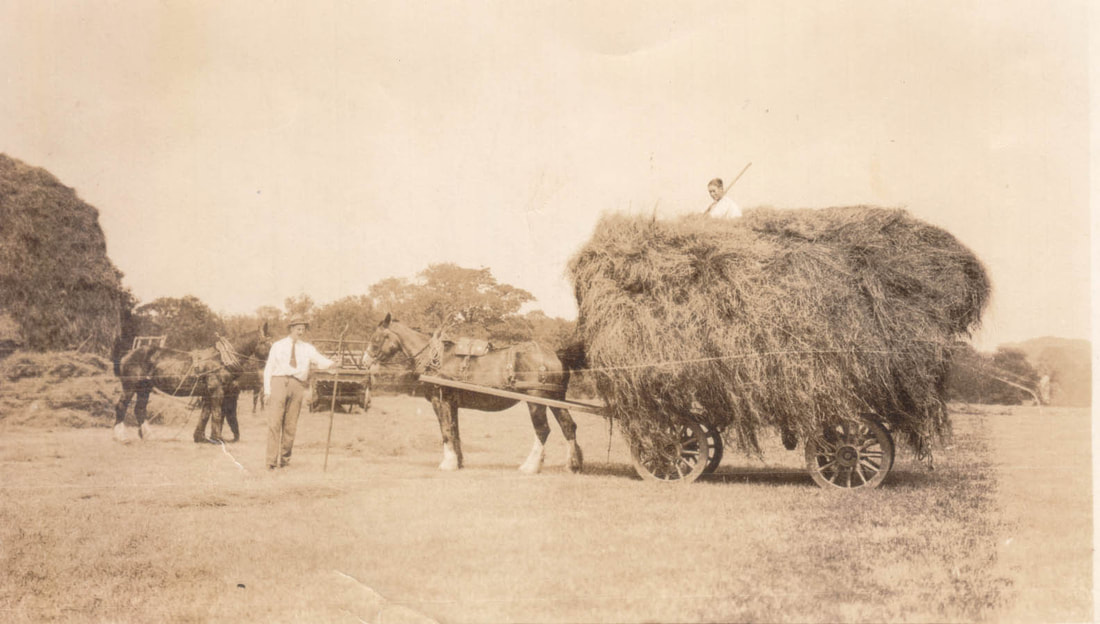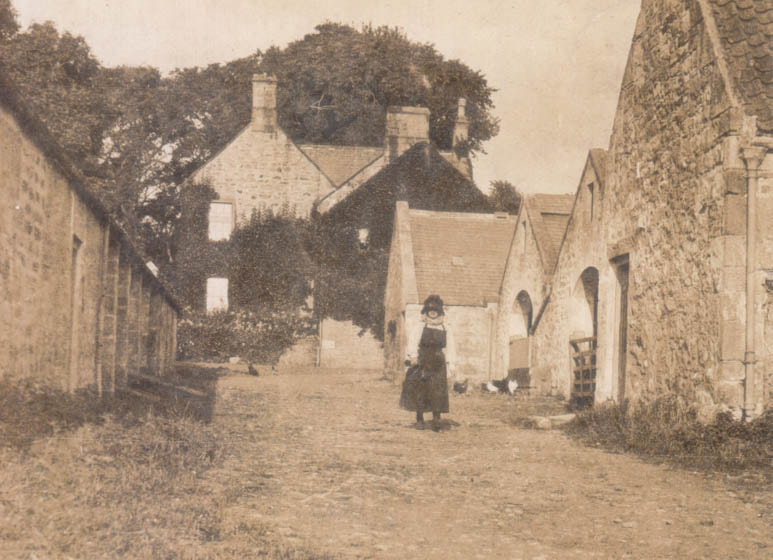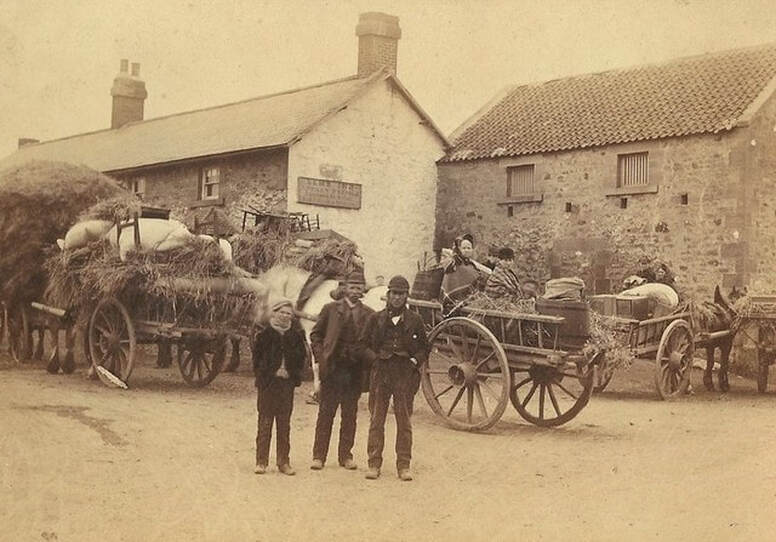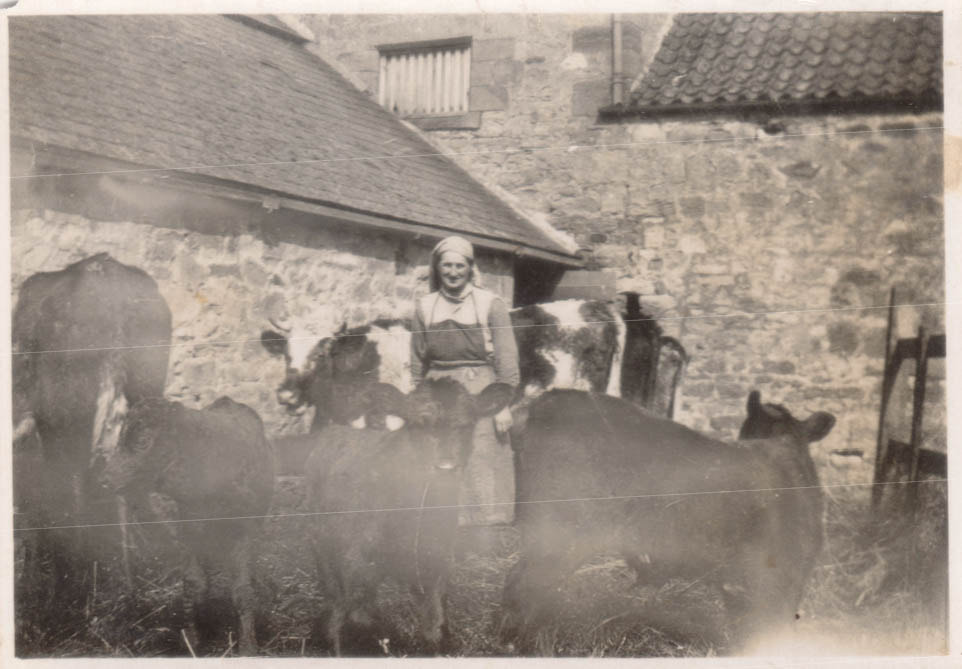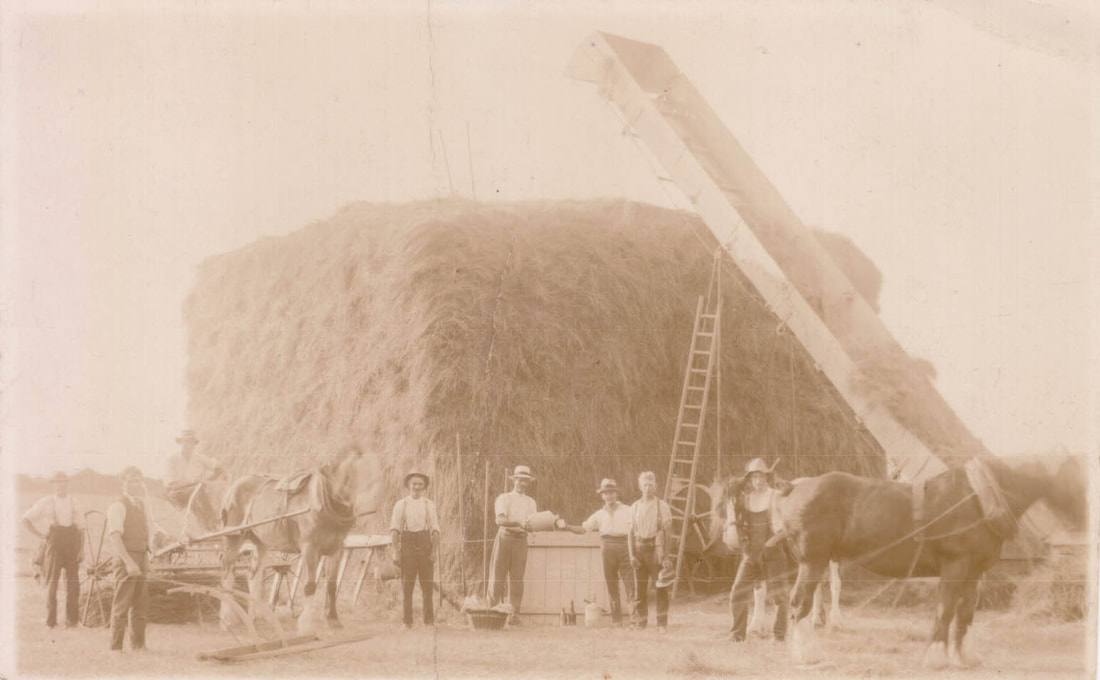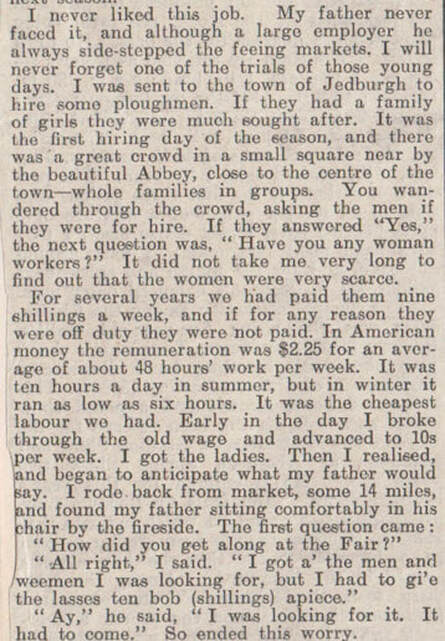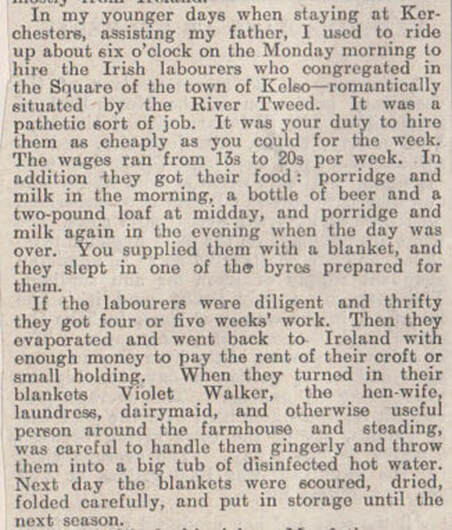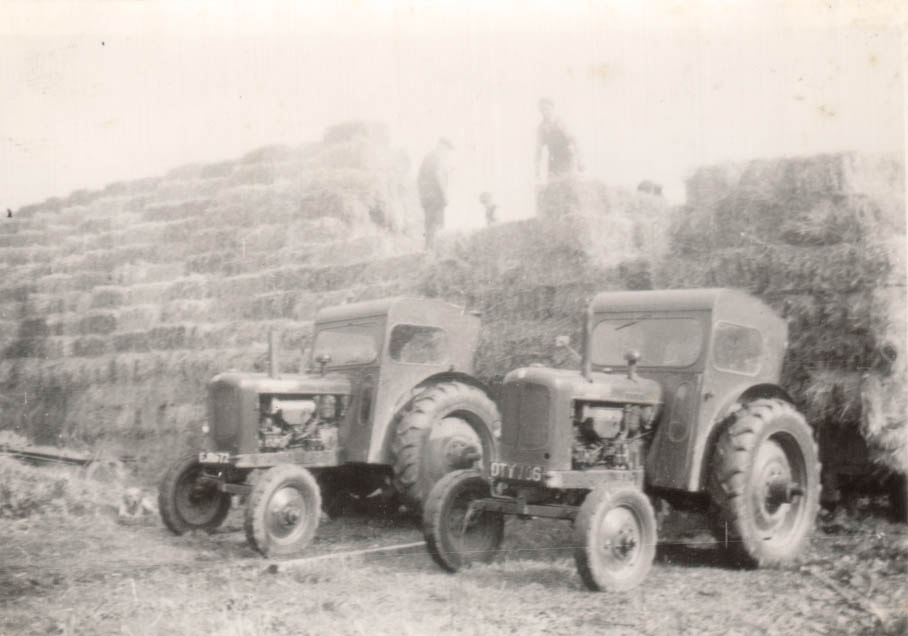|
January 1 [1833] 'Here my friends, we are just entered again upon another New Year!!! Struggling against debts, taxes, tithes and feudal impositions, these are trying things.' The above extract dated 1st January 1833, is the opening line from the diary of William Brewis, a farmer of Throphill Hall Farm, Mitford. It covers 17 years from 1833 until his death in 1850. It reflects upon the concerns, economic and political of the time that faced farmers in rural Northumberland and beyond. There is much to learn about rural life of the period from diaries such as these which provide vital social commentary. And it was not all doom and gloom! There are family celebrations, fairs, festivals and other occasions of social and sporting events. William's political persuasion and his views on local, national and even international matters are never in doubt. Despite being his personal account, it is packed full of other people. He even had plenty to say about some of my own ancestors who happened to be his relatives too! This month's blog addresses a point raised amongst the fantastic feedback to 'Eight Easy Ways to create compelling Ancestral Life Stories'. Most ancestors will not have left diaries, letters, or had books written about them so how is it possible to learn more of their journeys? Voices from the past are everywhere, often hidden in plain sight. It's a case of knowing where to look and thinking 'outside the box'. They appear in books, old documents, newspapers, oral recordings, and in other people's diaries such as Williams. Farmers aside, a large percentage of the population was employed in agriculture as Hinds, Shepherds and Labourers. Huge numbers of people lived a transient life as they moved from farm to farm, often on an annual basis. Among the hinds* there are not many to be found who were born in the parish where they are at present employed; and very few are there who drew their first breath in the cottage which is now assigned to them, or even on the property which they enrich by the sweat of their brow. They are hired, for the most part, from year to year, on an agreement which binds them to their employer for twelve months, beginning and ending about Whitsuntide ... This provision of a female outworker as part of the Hind's 'Bond' or employment contract was peculiar to Northumberland, the eastern Scottish Borders and the Lothians. Author Dinah Iredale's guest blog of February 2014, provides an excellent overview of this practice. Her book 'Bondagers: The History of Women Farmworkers in Northumberland and South East Scotland' is an excellent source of information and references. Many of the quotations within this blog come from within its pages. Particularly the chapters covering Flitting, Hirings and workers' accommodation. The 'Flitting'Before the Flitting and Hiring, came the 'Speaking', where the farmer and hinds would discuss a potential extension of his contract for another year. The Hind was under no obligation to accept an offer and had the right to move and find another situation. 'Flitting Day' in Northumberland was the 12th May. (In the Scottish Borders and Lothians it was the 26th May which sometimes caused logistical issues.) Although referred to as 'The May' it bore no resemblance to festivities held elsewhere. Hastings Neville in 1909 recalls the scene as '… roads morning to evening thronged with carts piled high with the furniture and bedding of a large proportion of our population.' He further recalls ' the furniture in one cart piled to a dangerous height, with the grandfather clock lying lengthwise and risking its life on the top. In the second cart are the women and children seated on the bedding, caring for the caged canary and the cherished pelargonium which grew at the cottage window…'[2] There are mixed accounts over the 'flitting'. Some look back with affectionate nostalgia at what must have been quite an upheaval to undertake every year. 'Well, there were usually three carts. Oo got a' the furniture on the three carts. Usually, the third yin wis what they ca'ed a short cart, that was a sma' yin. And the mother usually went in the wi' the youngest bairns and the cat, if ye had yin, or the pig in a bag. It would lie squealin in the straw.' [3] Another lady recalls 'the cat would be the first thing to be 'packed' on flittin morning, in case it disappeared during the flurry'.[4] The 'flit' was so ingrained in some that even in old age they persisted with the annual move. One chap of 80 employed at East Bolton in 1910 when asked if he would stay replied, ' I've nivver been ony mair than a year in ony place an' I'm no 'gain tae begin in my old age.'[5] And another, on finally deciding to stay put, asked the farmer 'if he might have a couple of carts for a short time … Just to ta' take the furniture a bit doon the road.'[6] Others seem relieved to see the back of it. 'I'll tell you what I like best? Not having to flit every year. It was awful, thon flittin'. I remember driving a horse and cart through the square in Kelso with all the furniture and my mother up at the back.'[7] Older family members living with the next generation were also involved in the 'flit'. There are tales of 'Granny' passing away the previous night, but due to the shortage of time, being bundled in with the furniture to be dealt with on arrival at the other end! Very often the vacated cottage would receive its new occupants later the same day. Leaving the vacated cottage clean and tidy with coals and kindling ready for the incoming tenants to light a fire seems to have been an unwritten code. That was if the fire grate had not gone on the cart too, as was usual in earlier periods. HousingThere are many accounts of the accommodation provided for farmworkers, some foul and some fair. It is generally accepted that before the nineteenth-century reforms, the state of housing throughout Northumberland, the Scottish Borders and Lothians was generally poor. Some accounts dating from the twentieth century are not pretty reading either. W.S. Gilly D.D., Vicar of Norham (1831) and Canon of Durham drew attention to the poor conditions of labourers' cottages and campaigned for changes. He refers to the cottages as 'miserable hovels', where 'the walls look as if they will scarcely hold together' and 'the thatch yawning to admit wind and wet'. His book 'The Peasantry of the Border: An Appeal on Their Behalf' contains some useful background information. In 1805 George Culley and John Bailey noted in a report that they had seen some significant housing improvements. That '…those [buildings] erected of later years are better adapted to the various purposes wanted on extensive farms and improved cultivation…' . Whereas their predecessors were 'very shabby and ill-contrived.'[8] (Those built from the mid-eighteenth century onwards often followed the same pattern of my own home. A long row of stone cottages, (6), of two rooms roughly 5m x 4m with a single door and two windows. There was a separate row of buildings housing the pigsty and the 'netty'.) An interesting snippet on the state of a vacated cottage appears in Walter White's book 'Northumberland and the Border': 'See an empty cottage before the hind has brought in his lumbering box there's, chairs and table, before he has set up his grate in the empty fireplace, fitted his window to the empty hole in the wall and you will think it's not good enough to be a stable.'[9] And another quoted from a first-hand account: ‘… about ninety years ago when there were no ovens and no windows; when people shifted they had ti' take their windows and fireplaces with them. No, the houses weren't all alike, the windows were different sizes, and they had to be made right with boards and cow dung.'[10] Other commentators note that, 'in the poorest dwellings the division between man and beast was only a low wooden partition. It was reckoned to be beneficial to 'let the coo see the fire'.[11] This is no isolated comment as there are frequent references to man and beast sharing a roof with little to separate them. When trying to connect with ancestors, it is helpful to list the things they did NOT own or even have access to. By today's standards toilets and running water were non-existent. In the words of Jean Willis of Alnwick in the 1920s and 1930s, 'the water tap [standpipe] served seven families and was a good distance from the house…. The netty was outside and … the wooden seat had two holes, a high one and a low one for a child.' (I remember the old disused 'double seater' outside the farmhouse at Longhoughton, but don't recollect a difference in the height of the seat!) Jean continues, 'The one netty had to serve three families ( about 15 people). It was no use if you were in a hurry and someone else was in. There was no sink to wash your hands after.'[12] It was not all grey, grim and smelly, though, as when 'put to rights' it was possible to make the cottages into a surprisingly comfortable and colourful home. As noted by the Rev Gilly as he describes the dresser with its 'large blue dishes and plates, some of Staffordshire ware, and other of Delf, intermixed with old china or porcelain tea-pots, cups and saucers…' and a 'handsome clock in the tall case and a chest of drawers'. He also remarks that there are books in most households with family bible taking pride of place. All this once past the cow that greeted him immediately inside the door! Standards of accommodation mattered, and a Hind was not above asking his prospective employer 'What sort of cottages have you?' before accepting a position.[13] At the Hirings in the late-nineteenth early twentieth century, another man's view was, 'family came first' and that 'a good house was worth £1 a week in the wage.'[14] Memories of the 'Hirings'These were often large gatherings where workers would be well turned out, sometimes wearing an emblem of their trade, such as a tuft of wool, whipcord, or a sprig of hawthorn in their hats. In 1827, Alexander Somerville, hoping to be hired as a Carter, also put a piece of straw in his mouth to show he was looking for a position. The Hirings were criticised as demeaning for those looking for work. In 1913 the general secretary of the Scottish Farm Servants Union noted '…the farmers went through the men pretty much the same way as they did their cattle.' With another lady remarking that 'my old aunt was a bondager. She said they used to stand on the cobbles at Alnwick and the farmers used to look them up and down as if they were horses.[15] An extract from the recollections of John Clay of Kerchesters, Sprouston and later Chicago suggests that some farmers also found the Hirings, an uncomfortable experience. John even found hiring casual labour by the week distasteful As the Hirings were also an occasion for folk to gather, it was a boom time for irregular marriages and socialising. Others went for this entertainment such as two girls who went to the hirings 'for sport'. 'The girls go the hirings and like it. They wear their best clothes and their white veils and bonnets. They often look a lump better than the gentry, for they look fresher like.'[16] There was also the inevitable element of drunkenness and disorderly behaviour. In 1875 at the March Hirings at Alnwick, Thomas Waite employed by John Smith of Longhoughton became involved in a brawl in which a policeman lost his life. (Later found to have been due to a heart attack rather than the ensuing riot.) Looking deeper into the lives of agricultural ancestors makes for a fascinating study. Uprooting family and belongings, sometimes on an annual basis may sound unsettling by modern standards. But voices from the past often speak fondly of the event. The crowded cottage with little privacy, no 'facilities' and a cow in the back room is beyond the comprehension of today's demands of at least one toilet per resident backside. But the past often tells of a warmth, colour and family unity absent in the present. Far from lost or even unrecorded, numerous sources contain the voices of rural men and women from the past. It is perhaps a case of tuning the modern ear to the correct frequency so they can be heard. Footnotes[1] W. S Gilly D.D. 'The Peasantry of the Border: An Appeal on Their Behalf' 2nd Edition, London, 1842 https://www.google.co.uk/books/edition/_/NexK1GL4XWAC?hl=en&sa=X&ved=2ahUKEwjUo-eX6efzAhUllIsKHUMUB1MQ7_IDegQIBxAD [2] Rev. Hastings M Neville, ‘A Corner in the North: Yesterday and Today with Border Folk’, 1909 [3] Ian MacDougall, Bondagers. Eight Scots Women Farm Workers, Tuckwell Press, 2000. Mary King b. 1905 describing a flitting circa 1916. Cited in Dinah Iredale 'Bondagers' [4] Barbara W Robertson, 'Family Life: Border Farm Workers in the Early Decades of the Twentieth Century', Scottish Life and Society. The Individual and Community Life, John Donald, Edinburgh, 2005. Cited in Dinah Iredale, 'Bondagers'. [5] Bolton Parish Description, Scottish Women's Rural Institute, 1974. Cited in Dinah Iredale's 'Bondagers' [6] Ellingham Women's Institute, Collectanea. Scraps of English Folklore, XI, 1904. https://www.tandfonline.com/doi/abs/10.1080/0015587X.1925.9718328 [7] The Scotsman, Wednesday 5 July 1978. Liz Taylor interview with Mary Rutherford formerly of Mellerstain. [8] John Bailey and George Culley, 'General View of the Agriculture of Northumberland, Cumberland and Westmorland.' 1805. Available through Google Books https://books.google.co.uk/books/about/General_View_of_the_Agriculture_of_the_C.html?id=A3ZbAAAAQAAJ&redir_esc=y [9] Walter White, Northumberland and the Border, London, 1859. Available through Archive.org. https://archive.org/details/northumberlanda00whitgoog/page/n7/mode/2up?view=theater [10] Rosalie E Bosanquet, 'In the Troublesome Times' 1929. Second-hand copies are readily available to purchase online. [11] Ian and Kathleen Whyte, 'The Changing Scottish Landscape 1500 – 1800', 1991. Cited in Dinah Iredale 'The Bondagers'. [12] Dinah Iredale, ‘Bondagers: The History of Women Farmworkers in Northumberland and South East Scotland’ 2nd Edition, Berwick, 2011. p. 105. [13] Henley, 'Employment of Children, Young Persons and Women in Agriculture' Royal Commission on Labour, HMSO, 1867. [14] Minnie Bell, School of Scottish Studies, University of Edinburgh. Cited by Dinah Iredale. [15] Katrina Porteous, 'The Bonny Fisher Lad', People's History Series Ltd, 2004. May Douglas, cited in Dinah Iredale's 'Bondagers'. [16] Arthur Wilson Fox, 'The Agricultural Labourer: Report upon The Poor Law Union of Glendale' (Northumberland), Royal Commission on Labour, HMSO, 1893. Cited in Dinah Iredale’s, 'Bondagers' Other Useful LinksDinah Iredale, 'Farming History - The Forgotten Workers' https://www.facebook.com/TheBondagers/ Matthew and George Culley: Travel Journals and Letters, 1765 – 1798. Available in part through Google Books https://books.google.co.uk/books?id=PwZhQUO4KlgC&printsec=frontcover&source=gbs_ge_summary_r&cad=0#v=onepage&q&f=false David R Stead, ‘The mobility of English tenant farmers, c. 1700–1850’ https://bahs.org.uk/AGHR/ARTICLES/51n2a4.pdf John Grey of Dilston, Berwick, 1841. A View of the Past and Present State of Agriculture in Northumberland and Details of Experiments with Various Manures.
https://books.google.co.uk/books?id=2kdiAAAAcAAJ&printsec=frontcover&source=gbs_atb&redir_esc=y#v=onepage&q&f=false
1 Comment
|
AuthorSusie Douglas Archives
August 2022
Categories |
Copyright © 2013 Borders Ancestry
Borders Ancestry is registered with the Information Commissioner's Office No ZA226102 https://ico.org.uk. Read our Privacy Policy
